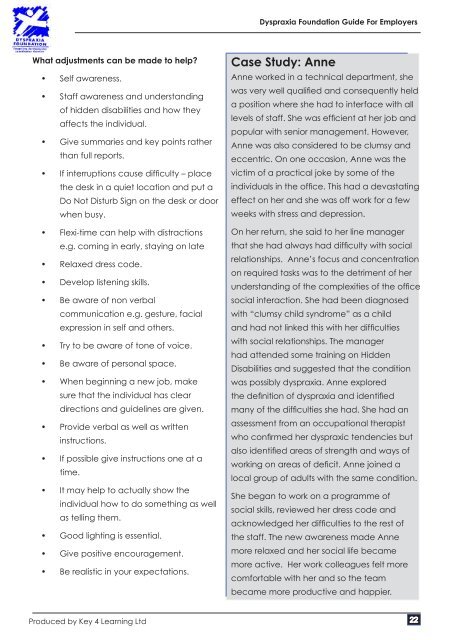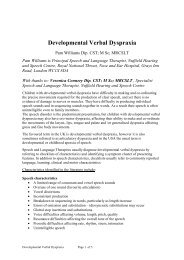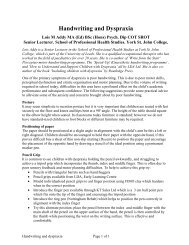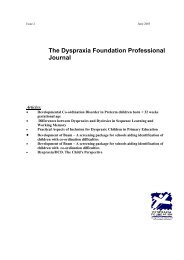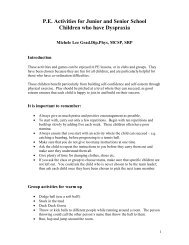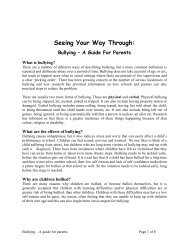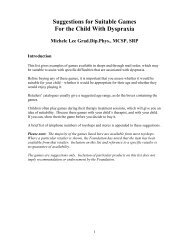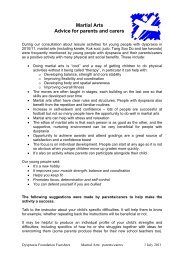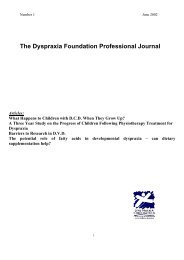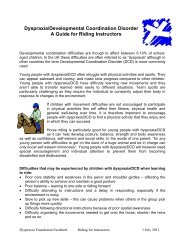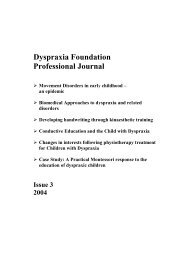Employers Guide - Dyspraxia Foundation
Employers Guide - Dyspraxia Foundation
Employers Guide - Dyspraxia Foundation
Create successful ePaper yourself
Turn your PDF publications into a flip-book with our unique Google optimized e-Paper software.
<strong>Dyspraxia</strong> <strong>Foundation</strong> <strong>Guide</strong> For <strong>Employers</strong><br />
What adjustments can be made to help?<br />
• Self awareness.<br />
• Staff awareness and understanding<br />
of hidden disabilities and how they<br />
affects the individual.<br />
• Give summaries and key points rather<br />
than full reports.<br />
• If interruptions cause difficulty – place<br />
the desk in a quiet location and put a<br />
Do Not Disturb Sign on the desk or door<br />
when busy.<br />
• Flexi-time can help with distractions<br />
e.g. coming in early, staying on late<br />
• Relaxed dress code.<br />
• Develop listening skills.<br />
• Be aware of non verbal<br />
communication e.g. gesture, facial<br />
expression in self and others.<br />
• Try to be aware of tone of voice.<br />
• Be aware of personal space.<br />
• When beginning a new job, make<br />
sure that the individual has clear<br />
directions and guidelines are given.<br />
• Provide verbal as well as written<br />
instructions.<br />
• If possible give instructions one at a<br />
time.<br />
• It may help to actually show the<br />
individual how to do something as well<br />
as telling them.<br />
• Good lighting is essential.<br />
• Give positive encouragement.<br />
• Be realistic in your expectations.<br />
Case Study: Anne<br />
Anne worked in a technical department, she<br />
was very well qualified and consequently held<br />
a position where she had to interface with all<br />
levels of staff. She was efficient at her job and<br />
popular with senior management. However,<br />
Anne was also considered to be clumsy and<br />
eccentric. On one occasion, Anne was the<br />
victim of a practical joke by some of the<br />
individuals in the office. This had a devastating<br />
effect on her and she was off work for a few<br />
weeks with stress and depression.<br />
On her return, she said to her line manager<br />
that she had always had difficulty with social<br />
relationships. Anne’s focus and concentration<br />
on required tasks was to the detriment of her<br />
understanding of the complexities of the office<br />
social interaction. She had been diagnosed<br />
with “clumsy child syndrome” as a child<br />
and had not linked this with her difficulties<br />
with social relationships. The manager<br />
had attended some training on Hidden<br />
Disabilities and suggested that the condition<br />
was possibly dyspraxia. Anne explored<br />
the definition of dyspraxia and identified<br />
many of the difficulties she had. She had an<br />
assessment from an occupational therapist<br />
who confirmed her dyspraxic tendencies but<br />
also identified areas of strength and ways of<br />
working on areas of deficit. Anne joined a<br />
local group of adults with the same condition.<br />
She began to work on a programme of<br />
social skills, reviewed her dress code and<br />
acknowledged her difficulties to the rest of<br />
the staff. The new awareness made Anne<br />
more relaxed and her social life became<br />
more active. Her work colleagues felt more<br />
comfortable with her and so the team<br />
became more productive and happier.<br />
Produced by Key 4 Learning Ltd


